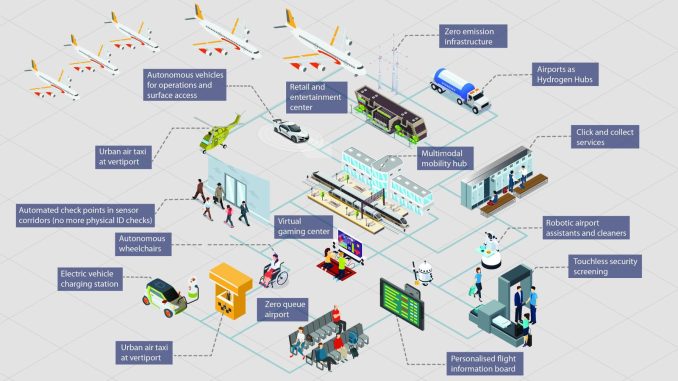
Imagine stepping into an airport where queues are relics of the past, replaced by seamless journeys orchestrated by intelligent machines. This isn’t science fiction – it’s the dawn of Airport 4.0, the cognitive era where airports transform from transit hubs into dynamic, personalized experiences.
As a frequent traveler myself, I’ve spent countless hours navigating the labyrinthine world of airports. The frustration of long lines, the stress of security checks, the wasted time waiting – it’s all too familiar. But Airport 4.0 paints a radically different picture. Facial recognition whisks me past security, AI-powered apps anticipate my needs, and personalized recommendations guide me to hidden gems within the terminal. This isn’t just a convenience; it’s a paradigm shift that unlocks a world of possibilities. Today, as we stand on the brink of the cognitive era, I’m keen to share my insights on how Airport 4.0 is reshaping the future of air travel, making it not just a journey from A to B but an experience in its own right.
A new report on Future of Airports from Markets and Markets Foresighting team delves into what will be a future airport.
A Connected, Seamless Journey
Gone are the days of long queues and paper boarding passes. The airports of tomorrow are embracing cutting-edge technology to enhance the entire travel experience. Facial recognition, biometric scans, and AI-driven security checks will become the norm, making the journey from check-in to boarding gate smoother and reducing passenger queuing time by 30-40%. This newfound efficiency gives us more time to explore the airport’s vibrant shops, delightful restaurants, and captivating entertainment options.
Integrated travel apps will be our trusted companions, managing our end-to-end journey with personalized services and targeted promotions. Alongside this, personalized baggage options will ensure we travel unburdened, allowing us to navigate the airport and engage in meaningful experiences effortlessly. These advancements will unlock new revenue streams for airports, such as click-and-collect services and virtual gaming centers. Reducing baggage drop-off and security queues will also open up terminal space for even more retail and entertainment offerings, freeing up approximately 15-20% of airport real estate.
More Diverse Customers
In the not-so-distant future, airports will welcome an even more diverse range of customers regarding age, physical ability, and cultural background. By 2040, the Middle East and Asia-Pacific regions will be at the forefront of global air passenger demand, and by 2045, Asia-Pacific will surpass North America in passenger traffic, driving the need for airports to adapt accordingly. This demand will enable access to new destinations and tier-2 city-to-tier-2 city direct journeys. As the global population ages, airports are adapting to ensure a comfortable travel experience for seniors. This will include touchless technology and smart signage to aid those with mobility or sensory impairments. Terminals will be designed with easy navigation in mind, minimizing long walks and standing and reducing physical strain. Other technologies for elderly travelers could include autonomous wheelchairs and augmented reality wayfinding.
We are witnessing a shift in the tourism landscape, with emerging micro-personas like solo travelers, experience seekers, and social media influencers. The merging of business and leisure travel, known as “bleisure,” is also on the rise. This evolving customer base allows airports to cater to their unique needs and desires, transforming a brief visit into an unforgettable experience.
Cognitive Airports
Future Airport 4.0
Markets and Markets
The journey to Airport 4.0 is driven by the seamless integration of IoT networks, 5G connectivity, data analytics, and AI. What began as Airport 2.0 with automation and self-service processes has evolved into Airport 4.0, where fully autonomous operations and AI-backed decision-making reign supreme. The application of AI in airport security, through real-time video analysis, biometric screening, and behavioral prediction, will ensure our safety without compromising efficiency.
This transformative era will also redefine the nature of airport jobs. As autonomous technology takes on cleaning, maintenance, and customer service tasks, human workers will have the opportunity to engage in more complex, intellectually stimulating roles. We will see continuous training for airport workers to adapt to changing technologies and procedures. So, get ready to share the terminal with robotic companions! We will encounter many cognitive assistants, from self-driving luggage carts and autonomous delivery robots to robotic cleaners and translators.
Multimodal Hubs
The transformation of airports into dynamic, multimodal mobility hubs will significantly increase footfall, driving revenue growth in non-aeronautical revenue. To become multimodal hubs, airports must enable seamless transfers between diverse travel modes and become part of a passenger-centric mobility system. The future airport will not just be a gateway but a hub where terrestrial and airborne technologies converge. Picture a future integrating driverless vehicles, autonomous flying taxis, and high-speed train terminals. Airports can utilize core skills, available land, and existing assets to incorporate Vertiports, enabling new urban air mobility market revenue streams. These hubs are part of the aerotropolis model, which will turn airports into destinations, shifting their role from merely departure points for flights to places with their attractions.
Net-Zero Airports
The future is not just about getting there; it’s about getting there responsibly. Airports are transforming into green oases with vertical gardens, solar panels, and innovative waste management systems. For example, green walls are being implemented to reduce temperature and improve air quality, while electric ground vehicles are cutting carbon emissions. Airports are even poised to become green hydrogen hubs, with hydrogen production serving not only airport vehicles but also the energy demands of the airport itself. Excitingly, hydrogen-powered aircraft could be on the horizon. There are currently 12 members of the international “Hydrogen Hub at Airport” network, which promotes the further expansion of hydrogen infrastructure in aviation. Airports in future could generate and consume hydrogen on site.
Revenue Shift
Up to now, the transformation of non-aeronautical revenue (NAR) has been slow. While the core business for airports will remain passenger services and operations, as they embrace technological and environmental trends, there will be new sources of NAR. These include integrating virtual and e-commerce, urban air mobility services, multimodal connectivity, energy hubs, and electric vehicle charging services. Post 2035, we expect NAR to account for 43% of total revenue.
Conclusion
This is just the beginning. Airports of the future will immerse us in an unparalleled travel experience where efficiency, personalization, and sustainability converge. I, for one, can’t wait to experience this future. As we embark on this journey, I invite you to envision the airport of tomorrow—where waiting is minimal, exploration is limitless, and the possibilities are endless. So, are you ready to board this transformative flight?
The article is written with contributions from Lynne Goulding, who leads the Foresighting team in Markets and Markets





Be the first to comment